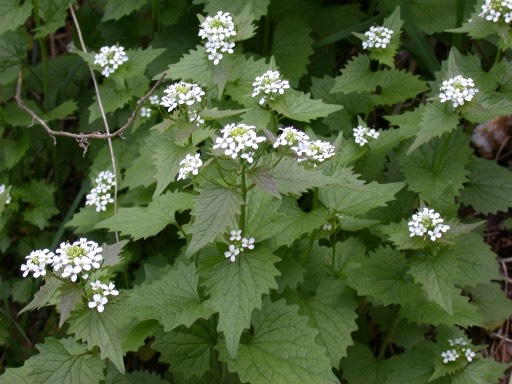
Garlic mustard invasion kills off dozens of native wildflower species and
harms the seedlings of native trees (photo by Jennifer Forman Orth).
What is an invasive species?
“Invasive” describes a plant, animal or microbe that’s nonnative (introduced from another part of the world) and undergoes extreme proliferation in its new location, causing harm to the local ecosystem. The population boom of an invasive species is partly because the parasites, predators, diseases and other natural checks on its population growth in its original home range are absent in its new home. Invasive species typically harm ecosystems by killing off or crowding out native species, changing key environmental factors such as resource availability and soil conditions, and disrupting mutually beneficial relationships between native species.
What harm do invasive plant species do?
They crowd out our native wildflowers and other native plants that have lived here for millions of years.
- Where nonnative invasive plants are abundant, populations of native plants get smaller and smaller and the risk of local extinction increases.
- Once they’re gone, many native species don’t come back, especially those whose seeds are dispersed only a very short distance—carried by ants, launched by projectile devices made by the plants, or “dispersed by gravity” (just falling to the ground).
They change the environment in ways that make life difficult or impossible for native plants.
- Many, like Norway maple and English ivy, cast dense shade that suppresses or kills most native plants.
- Some, like garlic mustard, are allelopathic, which means they secrete chemicals from their roots that poison native plants or poison the symbiotic fungi that native plants depend on for nutrients and water.
- Others change soil chemistry—for instance, pH or nitrogen availability—disrupting the finely tuned relationships among native plants, fungi, soil animals and soil microorganisms.
Native animals generally avoid eating them (one reason why they spread so prolifically!) including insects, which are vital links in all of the food chains that make up the food web.
- Fewer insects means fewer birds, mammals, frogs, turtles and other wildlife.
- Places where nonnative invasive plants are abundant are often “biological deserts” when it comes to animal life.
Which plant species are invasive in Rose Valley?
The most prolific and damaging invasive plants in Rose Valley include the following (click on the name for photos and detailed information):
- Amur honeysuckle (Lonicera maackii)
- border privet (Ligustrum oblongifolium)
- burningbush (Euonymus alatus)
- English ivy (Hedera helix) See tips on how to remove English ivy here.
- garlic mustard (Alliaria petiolata)
- goutweed (Aegopodium podagraria)
- Japanese barberry (Berberis thunbergii)
- Japanese honeysuckle (Lonicera japonica)
- Japanese knotweed (Fallopia japonica; formerly Polygonum cuspidatum)
- Japanese stiltgrass (Microstegium vimineum)
- lesser celandine (Ficaria verna; formerly Ranunculus ficaria)
- mile-a-minute (Persicaria perfoliata; formerly Polygonum perfoliatum)
- multiflora rose (Rosa multiflora)
- Norway maple (Acer platanoides)
- Oriental bittersweet (Celastrus orbiculatus)
What can we do to reduce or eradicate invasive plant species?
Follow the motto “REMOVE AND REPLACE.” First, remove or kill the invasive plants using the best management practices for the particular species (click on the names above for more detailed information). Then replant the space with native species appropriate to the site conditions. Planting gives the native plants a head start. Without that intervention, invasive plants are likely to beat the natives in the race to recolonize the space.
WARNING: Herbicides are harmful to native plant and animal life, water quality and human health unless used sparingly and in strict accordance with manufacturers’ instructions. Where herbiciding is suggested in the table below, spot-application or “painting”—rather than spraying—should be used whenever possible, herbicides should be applied only on days with little or no wind, and application near streams and wetlands should be avoided.
Get more information on controlling
invasive plant species here.